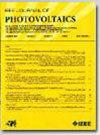Electrical Modeling of Bifacial PV Modules
IF 2.6
3区 工程技术
Q3 ENERGY & FUELS
引用次数: 0
Abstract
Although the bifacial photovoltaic (PV) module is now a mature technology, there still exists a gap in the literature on its electrical modeling and equivalent circuit representation. Most published studies have mainly focused on the photocurrent while overlooking other crucial parameters for the electrical response of the module. Even so, the photocurrent of the bifacial module is simplistically treated as the sum of individual currents of the front and rear sides, a hypothesis challenged in this study. Notably, our research has uncovered a discrepancy that can exceed 15%, and we address this issue by introducing a correction factor in this article. This article introduces a comprehensive electrical model that effectively integrates bifacial PV modules' front and rear sides into a single双面光伏组件的电气建模
虽然双面光伏组件已经是一种成熟的技术,但在其电气建模和等效电路表示方面的文献还存在空白。大多数已发表的研究主要集中在光电流上,而忽略了模块电响应的其他关键参数。即便如此,双面模块的光电流被简单地处理为前后两侧单个电流的总和,这一假设在本研究中受到挑战。值得注意的是,我们的研究发现了一个可能超过15%的差异,我们通过在本文中引入校正因子来解决这个问题。本文介绍了一个全面的电气模型,有效地将双面光伏模块的前后两面集成到一个单一的$-$电路表示中。这种新颖的模型采用单$-$二极管等效电路,将五个参数中的每一个作为单个侧参数的函数。室内和室外测量验证了该模型带来的精度提高,这有助于研究发电量和我们对双面光伏系统的理论认识。
本文章由计算机程序翻译,如有差异,请以英文原文为准。
求助全文
约1分钟内获得全文
求助全文
来源期刊

IEEE Journal of Photovoltaics
ENERGY & FUELS-MATERIALS SCIENCE, MULTIDISCIPLINARY
CiteScore
7.00
自引率
10.00%
发文量
206
期刊介绍:
The IEEE Journal of Photovoltaics is a peer-reviewed, archival publication reporting original and significant research results that advance the field of photovoltaics (PV). The PV field is diverse in its science base ranging from semiconductor and PV device physics to optics and the materials sciences. The journal publishes articles that connect this science base to PV science and technology. The intent is to publish original research results that are of primary interest to the photovoltaic specialist. The scope of the IEEE J. Photovoltaics incorporates: fundamentals and new concepts of PV conversion, including those based on nanostructured materials, low-dimensional physics, multiple charge generation, up/down converters, thermophotovoltaics, hot-carrier effects, plasmonics, metamorphic materials, luminescent concentrators, and rectennas; Si-based PV, including new cell designs, crystalline and non-crystalline Si, passivation, characterization and Si crystal growth; polycrystalline, amorphous and crystalline thin-film solar cell materials, including PV structures and solar cells based on II-VI, chalcopyrite, Si and other thin film absorbers; III-V PV materials, heterostructures, multijunction devices and concentrator PV; optics for light trapping, reflection control and concentration; organic PV including polymer, hybrid and dye sensitized solar cells; space PV including cell materials and PV devices, defects and reliability, environmental effects and protective materials; PV modeling and characterization methods; and other aspects of PV, including modules, power conditioning, inverters, balance-of-systems components, monitoring, analyses and simulations, and supporting PV module standards and measurements. Tutorial and review papers on these subjects are also published and occasionally special issues are published to treat particular areas in more depth and breadth.
 求助内容:
求助内容: 应助结果提醒方式:
应助结果提醒方式:


